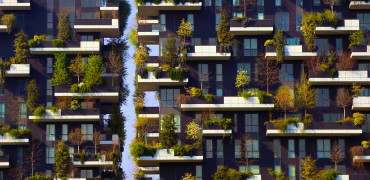Over the past few years the number of buildings with living walls both internally and on the external facade has grown in popularity.
Not only do they look nice but they also help to regulate indoor temperature, combat external air pollution, absorb rainwater and increase biodiversity.
So what are the most successful examples of living walls across the UK urban landscape and do they have more benefits than we first thought?
The benefits of a living wall
The insulation levels and air tightness of buildings is a concept that continues to gain emphases in the built environment. Reducing running costs, maintaining indoor air temperatures and blocking out pollutants are some of the many things that our buildings need to comply with in order to be premium stock; and living walls are a great way to achieve a number of these.
Foliage around a building acts as an insulation jacket, allowing buildings to stay warmer in winter and colder in summer; in fact tests have shown temperature differences of up to 17C between hard and vegetated surfaces. Furthermore, due to these energy changes in buildings that have a living wall, this solar radiation which is absorbed by the plants (transferring it into sensible and latent heat) can actually combat Urban Heat Island; an issue which I have previously spoken about here.
“A green living wall not only has the potential to keep a building colder in summer, it can also absorb solar radiation making its cooling potential a game changer in Urban Heat Islands like central London”.
Living walls are also proving to be great for wellbeing as greenery can provide uplifting and calming effects on people, reducing stress and purifying air so illness levels are reduced. Green space has also proven to increase workspace productivity, as I have explored previously here.
Living walls are also a great way to protect a building from wind and weather and are visual indicators of sustainable design, which can often help with planning permission.
The negatives of living walls
With the good, there is always the bad, and controversy surround living walls include the cost (both installation and maintenance) and that plants and building don’t mix well.
However, for the most it appears that that the pros outweigh the cons because good construction means the costs are kept down and the green wall will protect the buildings structure, doubling the life of the surface it is attached to.
The first living wall was actually installed in the UK in 2006 at a cost of £100,000 but unfortunately in 2009 it had completely died. The demise of the wall was down to poor design and irrigation. In 2010 it was announced that the wall would be replanted.
London’s largest green wall
Rubens Hotel in Victoria was the largest living wall in London at six storeys tall and covering an area of 350 square metres.
Currently it contains 10,000 herbaceous plants, provides a wildlife habitat and helps keep the hotel cooler in summer and warmer in winter – helping it meet its environmentally friendly targets.
While it is an outstanding example of a living wall on a hotel, The Athenaeum hotel (also in London) is an external living wall which is also worthy of admiration.
Installed in 2009 the living wall extends from ground level to the 10th floor penthouse. Designed by Patrick Blanc, an award winning French artist and botanist, the plants were chosen based on those that naturally grown on vertical locations – removing the need for soil and setting it apart from the Rubens Hotel wall.
Blanc has actually installed more than 140 vertical gardens including the Quai Branly Museum in Paris and the 21st Century of Contemporary Art museum in Kanazawa, Japan.
A green university
Not only has the University of East Anglia gone and got itself a living wall, its Crome Court accommodation block (where the living wall is located) has soared in terms of excelling the universities green credentials.
Winning the 2015 RICS ‘Design through Innovation’ award, winning the 2015 Green Gown Awards in the Built Environment category and winning the 2014 Construction Computing Awards ‘Collaboration Project of the Year’, the building also achieved BREEAM Excellent status and was one of the first projects in the UK to have achieved a fully-integrated BIM Level 2.
The buildings performance is also something to be admired due to it producing 95% less CO2 emissions than the same building under regulation standards due to high levels of insulation and the use of renewables.
Furthermore, the green living wall not only provided the building with an aesthetically interesting feature, it also enabled them to recycled rainwater which is used to irrigate it.
Bringing the outside in
Living walls can also be features for indoor environments. Fashion and home ware shop Anthropolgie installed a 3 storey 200 square foot wall in their Regents Street store back in 2009 and used recycled rainwater from the roof for irrigation.
The UK Green Building Council also have an interior living wall in their offices, and as a promoter for green infrastructure in the built environment, their wall is a great example of how our buildings have the ability to accommodate green space.
Final Thoughts
For me the cooling potential of living walls to combat Urban Heat Islands could be one the biggest benefits of all. Yes living walls looks amazing, yes they help with air quality and wellbeing, but the ability to combat an issue which has the potential to put immense strain on cities like London when temperatures in summer can soar, is ground breaking.
I think living walls are a win-win for any building that has the capability to house one and I look forward to seeing our urban environments go green as the popularity of living walls continues to grow.


